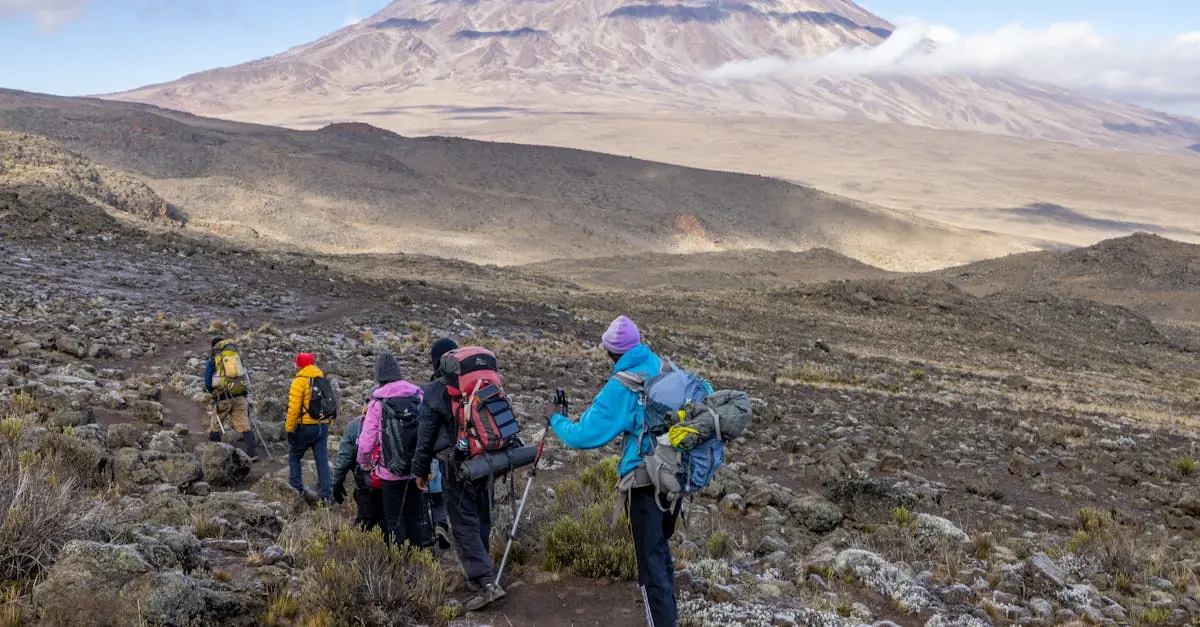Table of Contents
ToggleClimbing Mount Kilimanjaro is no small feat. It’s like signing up for a marathon, but instead of running, you’re trudging up a giant rock while battling altitude sickness and unpredictable weather. To conquer this majestic peak, having the right gear is as essential as remembering to pack your sense of humor. After all, nothing says “I’m ready for adventure” like a well-stocked backpack and a pair of socks that won’t make your feet feel like they’re in a sauna.
From sturdy boots that could survive a wrestling match with a goat to layers that can handle everything from sunshine to snow, the right equipment can make or break your trek. So, gear up and get ready to discover the must-haves that’ll keep you comfortable, safe, and maybe even a little stylish on your journey to the roof of Africa.
Essential Climbing Gear for Kilimanjaro
Choosing the right climbing gear for Kilimanjaro enhances comfort and safety during the trek. Essential items include quality footwear, appropriate clothing layers, and reliable backpacks.
Footwear Recommendations
Select sturdy hiking boots designed for rough terrain. Prioritize waterproof options that provide grip and support. Ensure the fit allows for thick socks, preventing blisters. Consider trail runners as an alternative for lighter weight. Break in footwear before the climb to avoid discomfort.
Clothing Layers
Opt for moisture-wicking base layers to manage sweat effectively. Insulation layers, such as fleece jackets, prevent overheating while maintaining warmth. Waterproof and windproof outer layers protect against harsh weather. Choose lightweight, breathable materials for comfort. Don’t forget extra layers for the summit; temperatures drop significantly at higher altitudes.
Backpacks and Daypacks
Select a durable backpack with adequate capacity for gear. Aim for a size between 40 to 65 liters for larger packs. Daypacks of 20 to 30 liters provide convenience for daily hikes. Ensure the pack has adjustable straps for a secure fit. Include pockets for easy access to water, snacks, and essential gear.
Camping Equipment
Selecting appropriate camping equipment is crucial for a successful Kilimanjaro climb. The right gear ensures comfort and safety throughout the journey.
Tent Options
Choose a high-quality tent that withstands harsh weather conditions. Freestanding options offer easy setup and stability on rocky terrain. Look for tents with good waterproof ratings, ideally above 3000mm for effective rain protection. Lightweight and durable materials like nylon or polyester provide a balanced combination of weight and strength. Two-person tents work well for individuals or small groups, while larger tents accommodate more people. Ensure tents have adequate ventilation to prevent condensation buildup at higher altitudes.
Sleeping Gear
Investing in proper sleeping gear contributes significantly to rest during the trek. A three-season sleeping bag rated between 0°F to 20°F accommodates the temperature range on Kilimanjaro. Consider an inflatable sleeping pad for added comfort and insulation from the cold ground. Lightweight and compact options are preferable for easy transport. A sleeping liner can enhance warmth and hygiene, making it easier to maintain clean sleeping conditions. Pillows with adjustable firmness or compressible designs also improve sleep quality, supporting the overall climbing experience.
Safety Gear
Safety gear plays a critical role in climbing Mount Kilimanjaro. It ensures preparedness for emergencies and enhances navigation throughout the trek.
First Aid Kits
A comprehensive first aid kit is essential for any climber. Kits should include items such as adhesive bandages, antiseptic wipes, pain relievers, and gauze pads. Climbers can also benefit from including blister care products and altitude sickness medications, as altitude sickness poses a risk during the ascent. It’s advisable to pack essential personal medications and a first aid manual. Ensure that the kit is lightweight and compact for easy carrying.
Navigation Tools
Accurate navigation tools are vital for a successful climb. GPS devices provide reliable guidance and should feature off-grid maps for clarity in remote areas. A topographic map complements a compass, allowing for enhanced understanding of the terrain. Climbers can choose smartphones with navigational apps, but keeping a physical map and compass as a backup is wise. Familiarity with these tools boosts confidence and reduces the chances of getting lost during the journey.
Accessories for Comfort
Climbing Mount Kilimanjaro requires thoughtful attention to accessories that enhance comfort during the trek. Different items contribute significantly to the overall experience.
Trekking Poles
Trekking poles provide added stability and support on uneven terrain. Many climbers find these essential, especially during descents to reduce strain on knees. Adjustable lengths cater to individual preferences, promoting a natural walking rhythm. Lightweight materials like aluminum or carbon fiber ensure durability without adding excessive weight. Some models even feature shock absorption, enhancing comfort on long stretches.
Water Bottles and Hydration Systems
Hydration remains critical during the climb. Choose water bottles with a capacity of 1 liter or more, allowing easy access to fluids without frequent stops. Insulated bottles help maintain temperature, keeping water cool during warm days and preventing freezing at higher altitudes. Hydration bladders also offer convenient alternatives, enabling hands-free drinking through tubes. Selecting BPA-free materials guarantees safety and aids in reducing environmental impact. Regular hydration encourages stamina, vital for completing the ascent to the summit.
Choosing the right gear for climbing Mount Kilimanjaro can significantly impact the overall experience. With the right equipment climbers can navigate challenges and enjoy the breathtaking scenery. Prioritizing sturdy boots and proper clothing layers ensures comfort and safety throughout the trek.
Additionally selecting a reliable backpack and quality camping gear will enhance the climbing experience. Safety gear and navigation tools are essential for preparedness and confidence on the mountain.
Finally investing in accessories like trekking poles and hydration solutions can make a noticeable difference. With the right preparations and gear climbers can focus on the adventure ahead and make lasting memories on Africa’s highest peak.





